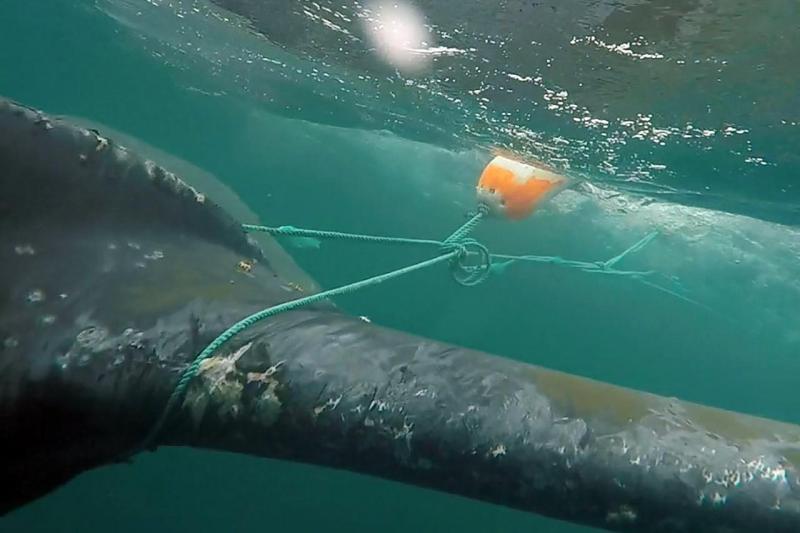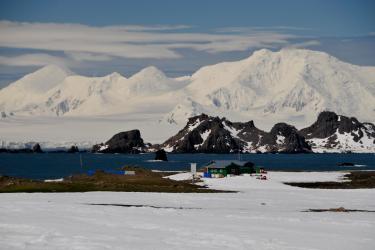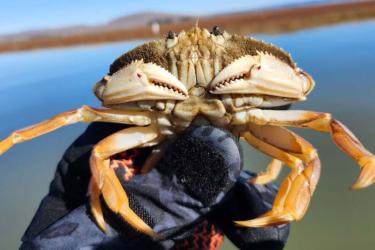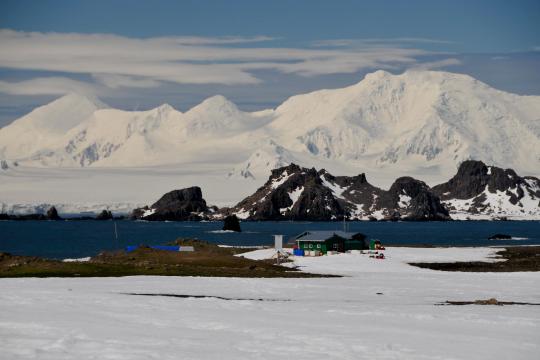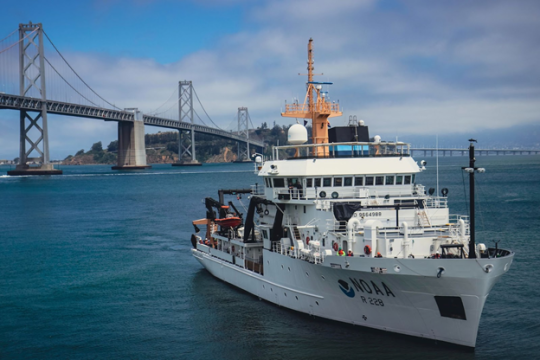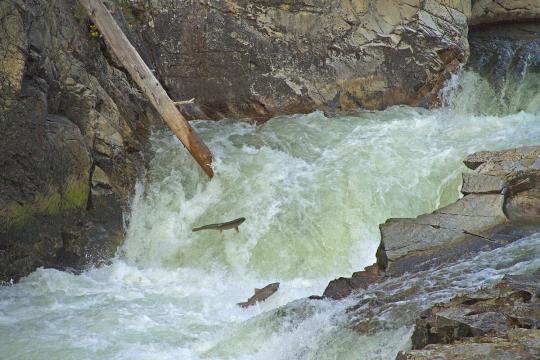NOAA scientists have combined the latest data on ocean conditions and marine life off the West Coast on a new data tool. It gives fishermen and fishery managers up-to-date ecosystem information that may help reduce the risk of whale entanglements. They hope it will also help the public understand how environmental factors influence the marine food web in a time of climate change.
“Resource managers and stakeholders can refer to the page for the latest information like prey abundance or sea surface temperatures before considering a season delay or other management options,” said Jarrod Santora, a research biologist at the NOAA Fisheries Southwest Fisheries Science Center who helped develop the new system.
Increase in Whale Entanglements
Between 2014 and 2019, NOAA Fisheries confirmed 163 large whale entanglements off Washington, Oregon, and California. By comparison, 64 whale entanglements were confirmed in the same region from 2008 to 2013. Humpback whales are the most common species entangled, but NOAA also confirmed gray, blue, fin, and minke whales entanglements. NOAA is responsible for recovering and protecting these whales under the Endangered Species Act and Marine Mammal Protection Act.
Experts are unable to attribute all entanglements to a specific fishery. However, where they can determine the cause, Dungeness crab fishing gear is commonly found. The Dungeness crab fishery is one of California's oldest fisheries and supports the most valuable annual harvest of seafood on the U.S. West Coast.
Fishermen understand that whale entanglements are bad for business and the ecosystem. “I hope that what comes out of this is the public becomes aware of the fact that fishermen are your true conservationists. We are the guys making our living out on the water and we have absolutely no desire to do anything to the environment that would have a negative effect. We are the conduit for the resource that belongs to you, the public. [...] The last thing we want is for the public to not be able to enjoy sustainable organic product from the ocean that is truly theirs. So if anything comes from all the work we are doing, I want to bring awareness to the public about the efforts the fishermen are making to make this work,” said Richard Ogg, a Dungeness crab commercial fisherman.
“We all love the ocean. That is why we are out there every day subjecting ourselves to weather conditions I can’t believe but that is what we love to do. The freedom of being on the water makes you speechless. It is an emotional feeling inside us. So if there is anything I want people to know it is we really truly love what we are doing and we are trying to do the best we can to keep that ocean the way it is now,” continued Ogg.
Connecting Ocean Conditions to Whale Entanglements
For the past several years, NOAA scientists have been working with fishermen and state managers to understand what led to this increase in entanglements and find solutions. The result of those efforts is this new tool that presents up-to-date information about the ecosystem and human activities related to whale entanglements. The information helps scientists, managers, and fishermen understand and mitigate the causes of large whale entanglements in the California Current marine ecosystem.
While reviewing information for the California Current Integrated Ecosystem Assessment, Jarrod Santora, a fish biologist at NOAA Fisheries’ Southwest Fisheries Science Center, realized certain ocean conditions increased the likelihood of whale entanglements. In 2015 and 2016, Jarrod and his colleagues discovered a unique combination of changes in sea surface temperature, prey distribution, other biological components, and human activity correlated with increased reports of whale entanglements.
“Whale entanglements are a complicated problem. We see changes in ocean climate conditions, changes in forage species, changes in whale populations, and changes in how the fishing community is responding,” said Santora.
In 2016, researchers had no way to convey ecosystem information to the fishing industry or resource managers as these changes were happening. This new tool helps by providing decision-makers timely information.
Available data include:
- Oceanographic Indicators
- Whale abundance
- Fishing gear reported in entanglements
- Locations of whale entanglement reports
- Crab fishery landings
- Prey abundance
The data on this page can be helpful for a spectrum of uses. This information can be used to understand and articulate the science around entanglement risk and apply risk assessment science to the decision-making process. It can also potentially inform individual fishermen’s actions such as understanding where and when risks could be higher or lower.
Whale entanglement reports provide the locations of where whales have been reported to be entangled. However, entangled whales do not always stay in the same area where the report came in. Where the whale was reported entangled is also not necessarily where they became entangled. The oceanographic indicators can help predict where whales will actually be.
NOAA Fisheries scientists continue to collect feedback from a working group of scientists, managers, fishermen, and others to make the site more informative and effective. This working group is convened by the California Department of Fish and Wildlife in partnership with the California Ocean Protection Council and NOAA Fisheries. The group is a forum for connecting with the Dungeness crab fleet and other stakeholders.
“Resource managers and stakeholders can refer to the webpage for the latest information like prey abundance or sea surface temperatures before considering a season delay or other management options,” said Santora. The Department continuously engages with the working group to review relevant information and make decisions with the best available information.
Jameal Samhouri, Ecosystem Science Program Manager at NOAA Fisheries Northwest Fisheries Science Center, uses data from this page to analyze tradeoffs between the risk of whale entanglements and impacts to California Dungeness crab fishery revenue from 2009–2019. He is modeling what might have happened to fishing revenue and whales under various possible management scenarios. “I hope that this tool provides decision-makers with scientifically robust and current information on ecosystem conditions so they can mitigate risk, at least cost, to the fishery,” said Samhouri.
As part of their efforts to develop reliable ocean condition indicators, Santora and other scientists developed a new indicator called habitat compression. This indicator tracks the area of cool and nutrient-rich water off the U.S. West Coast. Many species, including whales, feed in this area. When the offshore water is warmer, the cool water area is compressed shoreward into areas where fishing activity is generally more intense. These conditions heighten the risk of whale entanglement.
Scientists are also developing new indicators that incorporate the social and economic risk of entanglements and closures to fishermen. “What we are missing is a socio-economic risk assessment to balance this out. The ecological context to reduce whale entanglements is now firmly established, but what isn’t balanced is the fishing community’s risk. The socio-economics piece needs to be done, so we are developing a case study to review how the past two years of management decisions impacted fishing communities,” said Santora.
All of this work is a part of a larger effort, the California Current Integrated Ecosystem Assessment. The assessment engages scientists, stakeholders, and managers to integrate all components of an ecosystem, including human needs and activities, into the decision-making process. The aim is to help managers balance trade-offs and determine what is more likely to achieve desired goals, such as recovering and protecting whales.
Scientists, Managers, and Stakeholders Come Together
“The problem becomes, ‘what do you do about whale entanglements?’ There are no easy answers. There aren’t any easy solutions,” said Dan Lawson, a fisheries manager at the NOAA Fisheries West Coast Regional Office. Lawson participates in the Working Group as a representative of NOAA Fisheries Protected Resources program.
In 2016, a harmful algal bloom delayed the opening of the Dungeness crab fishing season. This bloom pushed the fishing effort later into the year, when whales are more common, and contributed to 22 entanglements in commercial Dungeness crab gear. “But since then, when the working group got together, we began to develop concepts around mitigating these issues. The reduction [in entanglements] has been significant. Our continued effort, in my opinion, has been very effective,” said Ogg. The working group has identified changes in fishing practices that have helped reduce whale entanglements. They have also kept managers and stakeholders better informed about what conditions make entanglements more likely. This new tool is meant to help inform these efforts.
The site was presented to stakeholders during a webinar in February and scientists received a lot of supportive feedback. Managers and stakeholders described a need for this information and wanted to be involved in adding to and adapting the information available on the page.
Ogg has been fishing commercially for more than 20 years. He got involved in the working group in 2015. “Something that needs to be understood is how much work the fishermen put into this to make this come together. It is not because of special equipment. It is because of our drive to reduce our interaction. Nobody wants to harm another marine mammal,” said Ogg.
